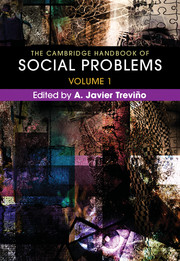Book contents
- The Cambridge Handbook of Social Problems
- The Cambridge Handbook of Social Problems
- Copyright page
- Contents
- About the Contributors
- Introduction
- Part I General Concerns and Orientations in the Study of Social Problems
- Part II Historical and Theoretical Issues in the Study of Social Problems
- Part III Problems of Discrimination and Inequality
- Part IV Problems of Institutions
- Chapter 26 Media and the Construction of Social Problems
- Chapter 27 Family Problems
- Chapter 28 Problems in Education
- Chapter 29 Problems of the Workplace and Workforce
- Chapter 30 Long-Term Unemployment in the United States
- Index
- References
Chapter 29 - Problems of the Workplace and Workforce
from Part IV - Problems of Institutions
Published online by Cambridge University Press: 16 March 2018
- The Cambridge Handbook of Social Problems
- The Cambridge Handbook of Social Problems
- Copyright page
- Contents
- About the Contributors
- Introduction
- Part I General Concerns and Orientations in the Study of Social Problems
- Part II Historical and Theoretical Issues in the Study of Social Problems
- Part III Problems of Discrimination and Inequality
- Part IV Problems of Institutions
- Chapter 26 Media and the Construction of Social Problems
- Chapter 27 Family Problems
- Chapter 28 Problems in Education
- Chapter 29 Problems of the Workplace and Workforce
- Chapter 30 Long-Term Unemployment in the United States
- Index
- References
Summary
Few activities are as central in the lives of individuals and important to society than work. The problems workers face affect not only them and their families, but they affect and are affected by society in very profound ways. Work has become increasingly precarious for millions of workers, and economic inequality has increased markedly in the United States, as the country has shifted from a principally goods-producing to a mainly services-providing economy. Workers have seen millions of jobs outsourced to parts of the world where labor costs are much lower, worker protections fewer (if existent at all), and the possibility of worker resistance much less. The future of work and workers will depend on many factors, but a coordinated effort by labor and human rights and environmental advocacy groups will be essential to restore some of the balance lost since the 1950s.
- Type
- Chapter
- Information
- The Cambridge Handbook of Social Problems , pp. 531 - 550Publisher: Cambridge University PressPrint publication year: 2018



